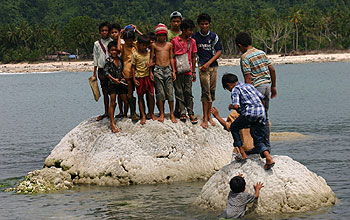Media Advisory 06-014
Lecture: "The Next Giant Sumatran Earthquake: From Science to Human Welfare"

Tsunami survivors stand atop a coral formation lifted above ocean's surface by the earthquake.
April 18, 2006
This material is available primarily for archival purposes. Telephone numbers or other contact information may be out of date; please see current contact information at media contacts.
On Monday, April 24, 2006, geologist Kerry Sieh of the California Institute of Technology will be at the National Science Foundation to deliver a special lecture on the Indian Ocean earthquake and tsunami of December 26, 2004--an event that ranks as one of the worst natural disasters in human history.
In his presentation, Sieh will talk about his own experiences as a researcher in the area during the immediate aftermath of the catastrophe. He will explain his conclusion that regions of the Earth previously thought to be at low risk of such events may actually be at high risk. And he will share his thoughts about what is required to protect the people living in those regions.
WHO: Geologist Kerry Sieh
WHAT: NSF Earth Sciences Special Lecture:
The Next Giant Sumatran Earthquake: From Science to Human Welfare
WHEN: Monday, April 24th, 2006, 1:00 P.M. EDT
WHERE: Room 110
National Science Foundation
4201 Wilson Blvd.
Arlington, VA 22230
-NSF-
Media Contacts
Cheryl Dybas, NSF, (703) 292-7734, email: cdybas@nsf.gov
Related Websites
NSF Special Report: After the Tsunami: http://www.nsf.gov/news/special_reports/tsunami/index.jsp
Tsunami Study Forces Rethinking of Quake Theory: http://www.nsf.gov/news/news_summ.jsp?cntn_id=106726&org=NSF&from=news
The U.S. National Science Foundation propels the nation forward by advancing fundamental research in all fields of science and engineering. NSF supports research and people by providing facilities, instruments and funding to support their ingenuity and sustain the U.S. as a global leader in research and innovation. With a fiscal year 2023 budget of $9.5 billion, NSF funds reach all 50 states through grants to nearly 2,000 colleges, universities and institutions. Each year, NSF receives more than 40,000 competitive proposals and makes about 11,000 new awards. Those awards include support for cooperative research with industry, Arctic and Antarctic research and operations, and U.S. participation in international scientific efforts.
Connect with us online
NSF website: nsf.gov
NSF News: nsf.gov/news
For News Media: nsf.gov/news/newsroom
Statistics: nsf.gov/statistics/
Awards database: nsf.gov/awardsearch/
Follow us on social
Twitter: twitter.com/NSF
Facebook: facebook.com/US.NSF
Instagram: instagram.com/nsfgov


